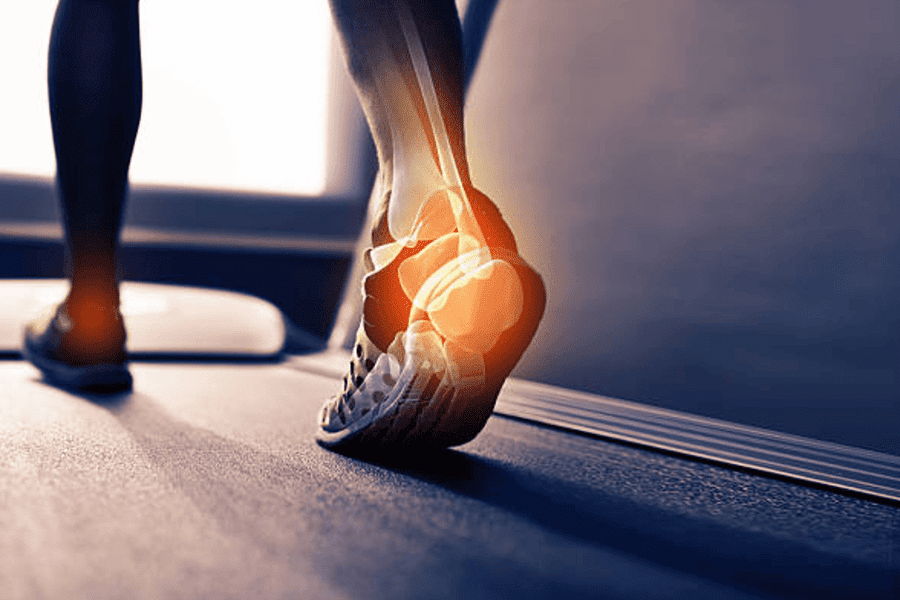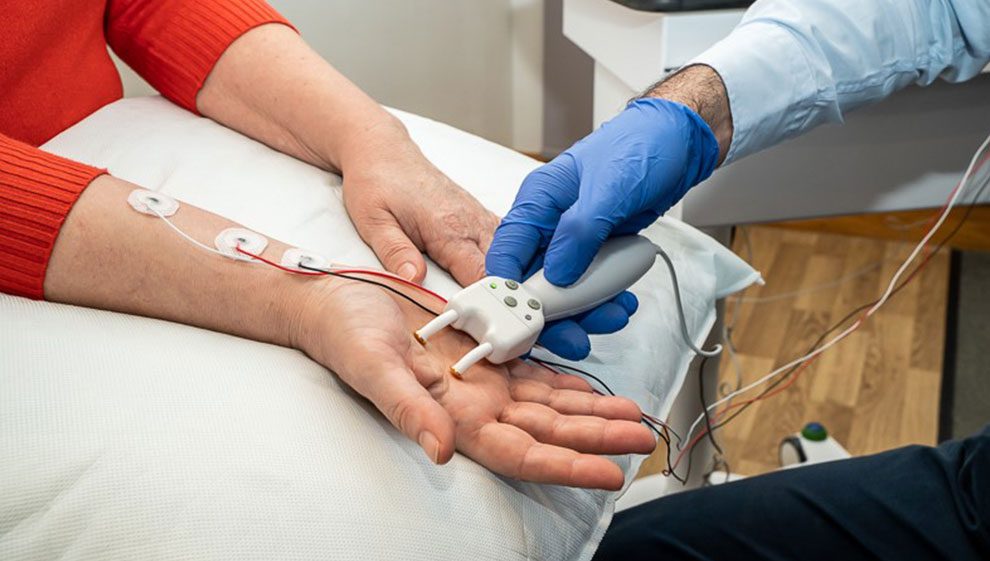Gait Analysis: Optimizing Patient Care

As dedicated physical therapists, you know that moving our bodies involves more than just taking steps. It’s a complicated series of mechanics that can affect how well our patients feel. Gait analysis allows you to uncover the nuances of how your patients walk and move. In this blog, we’re going to talk about gait analysis, what it means, and how you can use it to optimize care for your patients.
Understanding Gait Analysis: Figuring Out How People Move
Gait analysis is like a puzzle where we figure out how someone walks or runs. Imagine you’re solving a mystery – you’re finding out the secrets behind each step. Gait analysis means looking at information about timing, speed, and how things move during walking or running. This information will help you tailor treatment plans that address the root causes of your patient’s movement issues.
Why Gait Analysis Matters in Physical Therapy

Personalized Treatment Plans
Every patient is unique, and gait analysis provides you information to help their situation. By uncovering subtle irregularities in movement patterns, you’re equipped to develop tailored treatment plans that address the root causes of your patients’ issues.
Holistic Rehabilitation
Gait analysis becomes a guiding light for patients recovering from injuries, surgeries, or medical conditions. It enables you to monitor progress, fine-tune rehabilitation strategies, and ensure a comprehensive approach that leads to efficient recovery.
Performance Enhancement
Gait analysis isn’t limited to rehabilitation; it’s a key to unlocking athletic potential. Athletes aiming for peak performance can benefit immensely from this tool, as it highlights areas of improvement within movement mechanics, ultimately leading to enhanced performance and reduced injury risk.
A Step-By-Step Approach to Gait Analysis
Gait analysis requires a systematic approach that combines technology, observation, and expert analysis. Here’s how you can perform a proper gait analysis for your patients:
Data Collection: Utilize advanced tools such as motion sensors, cameras, and pressure mats to gather comprehensive movement data. These technologies capture the intricate nuances of your patient’s gait.
Observational Analysis: Begin with visual observation. Note posture, stride length, step width, and any asymmetries. This initial analysis sets the stage for deeper exploration.
Joint and Muscle Assessment: Dig deeper into joint and muscle movement. Evaluate range of motion, muscle activation patterns, and muscle imbalances that may be affecting gait.
Functional Tests: Incorporate functional tests that mimic real-life activities your patients engage in. Stair climbing, balance tasks, and sudden direction changes reveal how well gait adapts to varying conditions.
Analysis Tools: Leverage software and analysis platforms to break down collected data. Assess metrics like stride length, cadence, stance time, and swing time to quantify movement patterns.
Interpretation and Treatment Planning: Translate findings into actionable insights. Discuss observed deviations with the patient, addressing potential implications. Design a personalized treatment plan that includes targeted exercises, stretches, and interventions aimed at optimizing movement.
What Are the Best Pieces of Equipment to Use for Gait Analysis?
As a seasoned physical therapist, you understand that the right tools can make all the difference in uncovering the nuances of gait mechanics. Gait assessment equipment serves as your eyes and ears, enabling you to gather accurate data and gain insights into your patients’ movement patterns. These tools transform your practice from observation to precision, helping you tailor treatment plans that address the root causes of movement issues.
Motion Sensors: The Heartbeat of Gait Analysis

Motion sensors are the cornerstone of modern gait analysis. These advanced devices capture intricate movement details, offering a real-time look at how your patients walk or run. Inertial measurement units (IMUs) are a common choice, attaching to different body segments to provide data on joint angles, acceleration, and rotation. With motion sensors, you gain a comprehensive view of movement mechanics, allowing you to identify deviations and imbalances. Some benefits of using motion sensors during gait analysis include:
- Precision in data collection
- Real-time insights
- Quantitative analysis
- Ability to gather data on multiple joints simultaneously
- Individualized treatment plans
High-Speed Cameras: Capturing Every Step

High-speed cameras are a staple in gait analysis labs. These cameras record movement at an incredibly high frame rate, offering a slow-motion view of each step. This tool provides invaluable insights into joint angles, limb trajectories, and body mechanics, enhancing your ability to diagnose and treat gait-related issues accurately. Some benefits of high-speed cameras include:
- Detailed movement angles
- Slow-motion playback
- Accurate assessment of timing
- Visual feedback for patients
Pressure Mats: Mapping Foot Dynamics

Pressure mats, also known as force plates, play a critical role in understanding how your patients distribute weight during walking or running. These mats capture pressure patterns under the feet, shedding light on foot strike, weight distribution, and timing. This information is essential for diagnosing issues like overpronation, supination, or unequal weight distribution. Some benefits of pressure mats include:
- Foot pressure distribution
- Real-time feedback
- Quantitative analysis
- Balance and stability assessment
- Custom orthotic design
Electromyography (EMG): Unraveling Muscle Activation

EMG technology measures muscle activity through electrodes placed on the skin. By analyzing muscle activation patterns, you can pinpoint imbalances and weaknesses that contribute to abnormal gait. EMG is particularly beneficial when assessing conditions that affect muscle control, enabling you to design targeted interventions to address these issues. Benefits of using EMG technology include:
- Muscle activation Insight
- Objective data collection
- Identifying compensation patterns
- Customized treatment plans
- Progress tracking
Treadmills with Force Plates: Simulating Real-World Movement

Treadmills equipped with force plates provide a controlled environment to observe gait dynamics. Force plates integrated into the treadmill surface capture ground reaction forces, allowing you to analyze how your patients interact with the surface during walking or running. This setup mimics real-world conditions, aiding in accurate assessments and treatment planning. The top 5 benefits of using treadmills with force plates are:
- Simulation of natural movement
- Precise ground reaction forces
- Controlled conditions
- Variability and adaptation testing
- Gait retraining
Safety Equipment: Protect Your Patients with the Solo-Step Overhead Track System

Safety should be your #1 priority for your patients during gait analysis. Overhead track systems play a crucial role in gait analysis, offering several important benefits that enhance the accuracy, safety, and efficiency of the assessment process. Here’s why overhead track systems are important to use during gait analysis:
Safety and Fall Prevention
Gait analysis often involves individuals with movement difficulties, injuries, or balance issues. Overhead track systems provide a secure harnessing mechanism that prevents falls and provides a sense of safety during the assessment. This is particularly important when working with patients who may have an increased risk of stumbling or losing balance.
Unrestricted Movement
Overhead track systems allow for unrestricted movement within a controlled environment. This enables patients to walk or run naturally, free from concerns about potential falls or collisions, while clinicians can observe gait patterns without interference.
Real-World Observation
Overhead track systems enable clinicians to observe natural gait patterns in a safe and controlled setting. This is especially important for capturing authentic movement mechanics and understanding how individuals interact with their environment.
Real-Time Feedback
Overhead track systems support real-time feedback and interventions during gait analysis. Clinicians can use the harness to provide gentle guidance, prompting adjustments in posture, balance, or gait mechanics while the patient is walking or running.
Consistent Movement Patterns
Overhead track systems facilitate consistent movement patterns by reducing variability due to factors like changes in surface or environmental conditions. This consistency enhances the reliability of gait analysis data, making it easier to track progress and compare results across sessions.
Patient Comfort
Patients who have mobility challenges or a fear of falling are more comfortable while using an overhead track and harness system. The harness provides support while allowing individuals to move freely, promoting security and minimizing anxiety during the assessment.
The Solo-Step Overhead Track and Harness System offers your patients several benefits, such as:
- Reduced fear of falling
- Reduced chance of injury
- Increased confidence
- Creates a safe environment for balance, strength, and gait training
- Gives patients the ability to challenge themselves
Using overhead track systems like the Solo-Step also provides therapists a sense of safety and control. Therapists have extra support to protect their patients and themselves from injuries or back strain. Overhead track systems allow therapists to step back and view their patients’ total body alignment, which is crucial during gait analysis.
To learn more about the Solo-Step Overhead Track System, click the button below!
Conclusion
As physical therapists, you are at the forefront of guiding patients toward improved mobility and function. Incorporating gait analysis into your practice elevates your ability to create meaningful change. This technique allows you to look beyond the surface and understand the underlying mechanics of your patients’ movements, paving the way for precise, effective interventions.
By embracing the power of gait analysis, you step into a realm of unparalleled patient care. You become not just a healer, but a movement expert who can transform lives through the art of movement assessment. Your dedication to mastering gait analysis positions you as a leader in your field, ensuring that your patients receive the highest standard of care, tailored to their unique movement needs.
In the journey toward optimal patient outcomes, gait analysis isn’t just a tool – it’s a transformative force that empowers you to shape better lives, one step at a time.
To protect your patients during gait analysis, check out the Solo-Step Overhead Track System here!